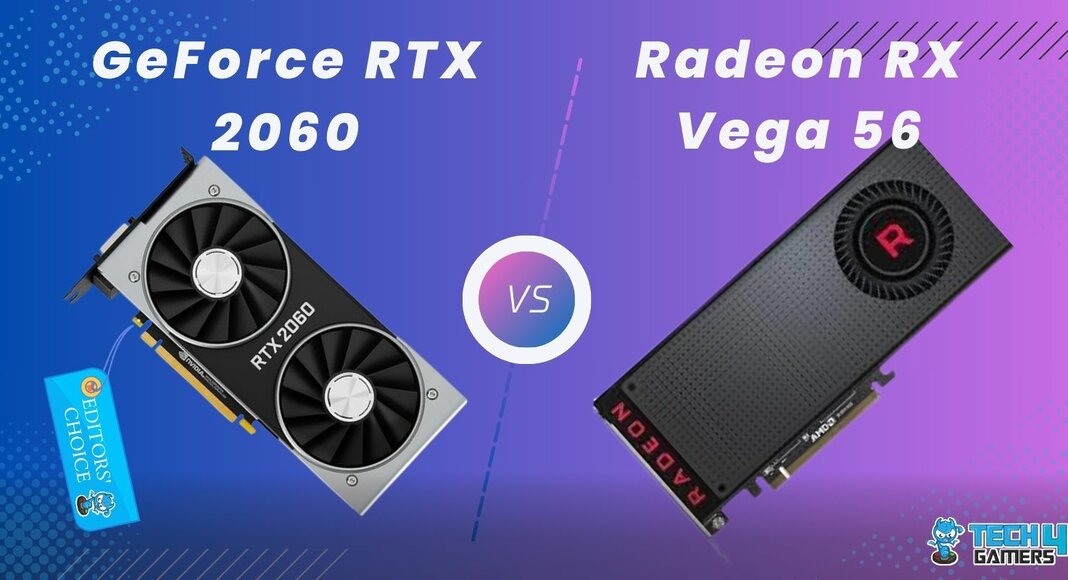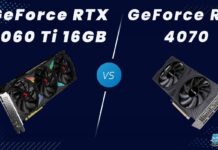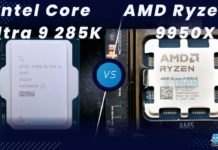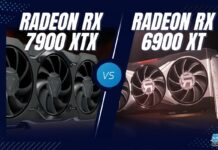Nvidia GeForce RTX 2060
Rated: 8.2/10
AMD Radeon RX Vega 56
Rated: 8.0/10
Pros And Cons
| GPU | Pros | Cons |
|---|---|---|
| GeForce RTX 2060 | ✅ Good for 1080p and even 1440p ✅ Easy overclocking | ❌ Gets overheated sometimes |
| Radeon RX Vega 56 | ✅ Support AMD FreeSync ✅ 8GB of HBM 2 memory | ❌ High power consumption ❌ Loud Fan |
- When we reckoned gaming performance, the RTX 2060 outperformed the RX Vega 56 by an 8.6% better average frame rate at 1080p.
- Based on our gaming temperature tests, the RX Vega 56 is 10.0% more thermally efficient than the RTX 2060.
- As of March 2024, these GPUs are available in renewed forms, and the RTX 2060 costs around $259, whereas the RX Vega is priced at about $179.
- For superior performance and energy efficiency, we suggest the RTX 2060, while the RX Vega 56 offers a more economical option for gaming.
Comparison Table
| Name | NVIDIA GeForce RTX 2060 | AMD Radeon RX Vega 56 |
|---|---|---|
| Shading Units | 2176 | 3584 |
| Base Clock | 1365 MHz | 1156 MHz |
| Boost Clock | 1680 MHz | 1471 MHz |
| Memory Clock | 14 Gbps | 1600 Mbps |
| Memory Bandwidth | 336 GB/s | 409.6 GB/s |
| Power Connectors | 1x 8-pin | 2x 8-pin |
| Bus Interface | PCIe 3.0 x16 | PCIe 3.0 x16 |
Architectural Difference
- Architecture: The RTX 2060 is based on Nvidia’s Turing architecture, while the RX Vega 56 employs the GCN 5.0 architecture from AMD.
- GPU Chip: Considering the chip used in GPU, the RTX 2060 is built using a TU106 chip fabricated on a 12nm node, while the RX Vega 56 uses a Vega 10 chip built in a 14nm process.
- VRAM: You get an ample 2048-bit 8GB HBM2 VRAM with the RX Vega 56, while Nvidia proffered a 192-bit 6GB GDDR6 memory with the RTX 2060.
- TDP: Looking at the power specifications, the RTX 2060 has an efficient 160W TDP, while the thermal design power of the RX Vega 56 is 210W.
- Supported Technologies: In terms of advanced technologies, the RTX 2060 features Nvidia DLSS for ray tracing and also has Tensor cores, while the RX Vega 56 lacks ray tracing capabilities.
AMD and NVIDIA rivalry has always been interesting. After having a thorough review of the Gigabyte RTX 2060, today we are going to compare the RTX 2060 vs RX Vega 56 GPU from AMD. We’ll analyze their specifications and architectural variances, then subject them to rigorous gaming tests to obtain accurate performance figures.
Gaming Benchmarks
To get accurate readings on performance, we benchmarked these two graphics cards in six intensive modern games at 1080p resolution on the highest settings. From these tests, we’ll find which GPU outperforms the other in terms of frame rates and temperature.
Test PC
- CPU: AMD Ryzen 7 7700X
- OS: Windows 11
- Motherboard: MSI B650M Project Zero Motherboard
- CPU Cooler: be quiet! Dark Rock Pro 4
- RAM: G.Skill Trident Z5 RGB 32GB DDR5-6600
- SSD: WD Black SN850 NVMe SSD
- Power Supply: ENERMAX REVOLUTION D.F. X 1050W
Assassin’s Creed Odyssey

- During our first Assassin’s Creed Odyssey gameplay, the RTX 2060 delivered a superb 61 FPS average, leading the RX Vega 56’s 49 FPS average by around 24.5%.
- Regarding the low 1% performance times, the RX Vega 56 managed a good 46 FPS, while the RTX 2060 was again leading with 52 FPS.
Hitman 2

- In Hitman 2, we noted that the RTX 2060 averaged 82 FPS, outperforming the RX Vega 56’s 78 FPS by 5.1%.
- Coming to the low 1% frame rate, the RX Vega 56 achieved a respectable 59 FPS, while the RTX 2060 lagged with 57 FPS.
Grand Theft Auto V

- The RTX 2060 achieved an impressive 100 FPS average in Assassin’s Creed Odyssey, surpassing the RX Vega 56’s 83 FPS by 20.5%.
- In terms of the low 1% performance, the RX Vega 56 managed to deliver 55 FPS, trailing behind the RTX 2060’s amazing 65 FPS.
Shadow Of The Tomb Raider

- While playing Shadow of the Tomb Raider, the RTX 2060 outpaced the RX Vega 56’s 91 FPS by about 4.4% with a 95 FPS average.
- The RX Vega 56 submitted a low 1% frame rate of 76 FPS, whereas the RTX 2060 led with 81 FPS at its worst 1%.
Far Cry 5

- In our Assassin’s Creed Odyssey tests, the RTX 2060 averaged an impressive 101 FPS, and the RX Vega 56 also submitted the same average frame rate.
- The RX Vega 56 still achieved a commendable low 1% frame rate of 85 FPS in this game, and the RTX 2060 could deliver only 74 FPS.
The Witcher 3

- In our last The Witcher 3 session, the RTX 2060 performed exceptionally well, averaging 104 FPS and outclassing the RX Vega 56’s 98 FPS by 6.1%.
- The RX Vega 56 delivered 86 FPS at its low 1% performance, trailing the leading RTX 2060, which achieved 89 FPS.
Overall Gaming Performance
| Stats | NVIDIA GeForce RTX 2060 | AMD Radeon RX Vega 56 |
|---|---|---|
| Average FPS | 90.5 📈 | 83.3 📈 |
| Low 1% FPS | 69.7 📉 | 67.8 📉 |
| Winner: Nvidia GeForce RTX 2060 | ||
In our gaming tests at 1080p resolution, we found that the RTX 2060 furnishes 8.6% higher average frame rates than the RX Vega 56. When examining performance in the lowest 1% scenarios, the RTX 2060 maintains its lead over the RX Vega 56, delivering approximately 2.8% better performance.
Thermal Efficiency
| Stats | NVIDIA GeForce RTX 2060 | AMD Radeon RX Vega 56 |
|---|---|---|
| Average Gaming Temperaure(°C) | 61.8 🌡️ | 56.2 🌡️ |
| Winner: AMD Radeon RX Vega 56 | ||
Following our analysis of GPU thermal performance during gaming, the Radeon RX Vega 56 proved superior heat management. Our data indicates that the RX Vega 56 exhibited roughly 10.0% greater thermal efficiency than the RTX 2060.
Price And Availability
| GPU | Launch MSRP | Current Price |
|---|---|---|
| GeForce RTX 2060 | 💲349 | 💲259 (Refurbished) |
| Radeon RX Vega 56 | 💲399 | 💲179 (Refurbished) |
| Price Difference | 14.3% | 44.4% |
The launch prices for these low-tier GPUs were not high, and now they are only available in refurbished condition. Currently, the RX Vega 56 costs about 44.4% less than the RTX 2060. Despite the performance difference being less than the price difference, the RX Vega 56 offers greater value.
Final Verdict: What Do We Recommend?
GeForce RTX 2060: The RTX 2060 remains an excellent choice for 1080p gaming, offering strong performance while also being power-efficient. It features Nvidia DLSS support and enables ray tracing.
Radeon RX Vega 56: The RX Vega 56 is also good enough for 1080p gaming. This card has a bigger 8GB VRAM and it supports AMD FreeSync. Additionally, this card has very good thermal management capabilities.
We recommend the RTX 2060 to enjoy a better gaming experience while maintaining power efficiency. Alternatively, if you’re looking to enjoy games without breaking the bank on a GPU, the RX Vega 56 is a great choice.
More From RTX 2060:
Thank you! Please share your positive feedback. 🔋
How could we improve this post? Please Help us. 😔
[Comparisons Expert]
Abdemanaf is a skilled creative writer who has been honing his craft since 2011. While initially working in different fields, he found a passion for technology and has been exploring the tech world since early 2015. Over the years, he has developed an in-depth knowledge of the latest tech trends and product offerings by various companies.
Abdemanaf’s writing reflects his analytical mindset and ability to think critically. He has a knack for breaking down complex technical information into easily digestible pieces, making his articles engaging and accessible to readers from all backgrounds. In February 2022, he joined Tech4Gamers as a blog and product comparison writer, where he has been able to hone his skills further.
As a writer, Abdemanaf is dedicated to staying up-to-date with the latest technological advancements and trends, enabling him to provide readers with the most relevant and accurate information. He is always eager to learn more and is constantly seeking new challenges to improve his skills.
Get In Touch: manaf@tech4gamers.com







